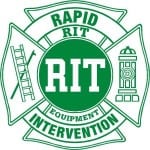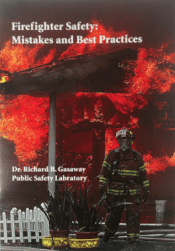I would like to share the results of a series of informal polls I have been conducting over a several year period. I conducted these surveys during my Firefighter Safety: Mistakes & Best Practices programs. Roughly 7,000 first responders have participated. There is nothing scientific about this survey or the results. It was merely a series of questions asked of participants, followed by some discussion. The results are: Many departments are giving lip service to rapid intervention.
R.I.T. – Rapid Intervention Team
 There are many critical tasks to be performed by responders operating at the scene of a structure fire or any other emergency scene, for that matter. And, for the most part, departments are well-prepared and ready to provide high quality service to the customer in the form of efforts to save lives and property. But what about our preparation to save our own?
There are many critical tasks to be performed by responders operating at the scene of a structure fire or any other emergency scene, for that matter. And, for the most part, departments are well-prepared and ready to provide high quality service to the customer in the form of efforts to save lives and property. But what about our preparation to save our own?
A Rapid Intervention Team (R.I.T.) can go by many names. Call it what you wish. The purpose is to have a team of emergency responders standing by in the event an individual, crew, or multiple crews, get into a situation they cannot get out of or need help getting out of.
There are many high quality training programs available to teach emergency responders how to perform the tasks of rapid intervention. The first one I took was in the mid 1990s taught by (then) Pittsburgh Firefighter Jim Crawford. Inspired by the tragic loss of firefighters at the Bricelyn Street fire, Crawford created a program to teach firefighters how to access and quickly remove firefighters in trouble. I remember being in awe of his knowledge and how he taught me things that I’d never been taught and new ways of doing things that were so innovative.
The point of bringing this training up is… I attended it in the 1990s! Rapid intervention is not a new concept. The lessons learned from the deployment of rapid intervention teams have led to modifications of the programs and dispelled mythical beliefs that a team of 2-4 can effectively perform a rescue of downed firefighters and emergency responders (see the extensive studies of the Bret Tarver line-of-duty death in Phoenix for a good assessment of what it takes to perform a rapid intervention.
As many experts have (rightfully) noted, rapid intervention isn’t really rapid. It’s often resource intensive and takes more time than most anticipate. But that’s a discussion for another day.
L.I.P. – Lax In Preparation
 As the title of this article asserts, many emergency responder departments are giving lip service to rapid intervention. Meaning, they are lax in preparation. How do I know this? Back to the poll. One of the inquiries I use to start the conversation is quite simply: Raise your hand if you have been trained in rapid intervention? In most cases the results make me want to cry, literally. Typically, it’s less than 10% of the attendees.
As the title of this article asserts, many emergency responder departments are giving lip service to rapid intervention. Meaning, they are lax in preparation. How do I know this? Back to the poll. One of the inquiries I use to start the conversation is quite simply: Raise your hand if you have been trained in rapid intervention? In most cases the results make me want to cry, literally. Typically, it’s less than 10% of the attendees.
The attendee make-up at some of my classes is skewed toward the command-level officers. But that’s no excuse. If a command-level officer is going to command an incident that holds any potential for a R.I.T. activation, that commander should be trained on what the R.I.T. is going to be doing and how they are going to do it. Not to mention, the commander should also be trained on how to command an incident with a R.I.T. activation (which brings a special set of challenges to the command team).
Why the L.I.P.?
Why… how… could emergency departments be so lax in preparation for a rapid intervention? This has also been part of my informal inquiry to the participants in my classes. I want to know… what drives the decisions related to, or the inaction related to, rapid intervention. Here are some of the responses:
1. We’ve never had the need to use a R.I.T..
2. Our department’s never had a close call or a near-miss.
3. We ensure our members are never in a position to need a R.I.T..
4. We can’t keep up with the basic training we’re supposed to be doing as it is.
5. We don’t have the money to train our members on R.I.T..
6. There’s no one in our region qualified to teach R.I.T..
7. Our chief/commander doesn’t support the concept of R.I.T..
8. We don’t have enough emergency responders at a scene to staff a R.I.T..
9. We depend on our neighboring department to serve as our R.I.T..
10. Our department has never offered the training.
And maybe there are a few more that don’t come to mind at the moment.
The point is, there is never a shortage of excuses for why emergency responders are not being trained in rapid intervention. None of them are good enough. Where the will is strong, a way is always found. When emergency responders find themselves, unexpectedly, in a tight spot, we owe it to them to be well-staffed, well-trained and well-prepared to give them every chance of survival.
Emergency Responders are some of the most creative problem solvers on the face of the earth. It’s time to apply that creativity to rapid intervention and stop giving it L.I.P. service. We all took an oath or vowed to do our very best to save lives. Sometimes those lives… are our brothers and sisters.
R.I.T. a s punishment
s punishment
Some emergency responders have shared with me their belief that being assigned to serve as the rapid intervention team is perceived as a form of punishment. These emergency responders often say things like: “Everyone else gets to have fun while we just stand around doing nothing.”
An emergency responder whose mindset about R.I.T. is doing “nothing” has failed to understand the critical duties of a R.I.T.. It’s hard to think of a duty any more important than being part of the team that saves the lives of fellow emergency responders. If the mindset is flawed, so will be the preparation and vigilance.
R.I.T. is for the weak
There are departments that, with purposeful intent, assign their weakest companies to serve as the R.I.T.. Perhaps the logic is, put the “A-Team” players in for the fight and you won’t need a R.I.T.. Or, if you put the “D-Team” players in the fight there may be a greater likelihood of needing a R.I.T..
Perhaps the best solution to this problem is to ensure there are no “D-Teams” on your emergency scene. Invest the time to ensure that all members can perform their duties competently. I understand these words are easier to type than the actions are to implement.
Rich Gasaway’s Advice
 The first thing I recommend is for every member of every department to come to the stark realization that being an emergency responder is dangerous work and no matter how well-trained we are or how experienced we are, unexpected things can and will happen. To be of the mindset that it will never happen on your emergency scene is quite literally, delusional.
The first thing I recommend is for every member of every department to come to the stark realization that being an emergency responder is dangerous work and no matter how well-trained we are or how experienced we are, unexpected things can and will happen. To be of the mindset that it will never happen on your emergency scene is quite literally, delusional.
I hope it never does happen on your emergency scene. But if it does, you better be well-prepared because you’re only going to get one chance – often with a rapidly closing window of opportunity – to get it right.
Make sure all members are trained in rapid intervention and that training includes realistic scenarios that demonstrate, in real time, how difficult rapid intervention really is.
The one regret that I have, looking back on the time I served as an incident commander, is how grossly understaffed my rapid intervention teams were. I struggle to recall any incident where the team was more than 4 or 5 members. This is simply not enough people, even if they are expertly trained and highly experienced.
Departments that cannot muster enough members to staff their own R.I.T. should use automatic aid agreements to bring the R.I.T. from a neighboring community (ensuring those members are adequately trained to perform a rescue of your members).
Commanders need to be trained on how to command incidents during R.I.T. operations. An emergency responder rescue scenario is complex and stressful. The emergency does not get put on hold while emergency responder rescue efforts are undertaken. The rescue operations, essentially, becomes an incident within the incident and requires a specially trained command-level officer (separate from, yet reporting to, the incident commander). This person coordinates the R.I.T..
This will not be an easy task. This will be a very stressful, highly emotional, dynamically changing, time-compressed, complex rescue operation. Realistic preparation and practice will improve the likelihood of success.
Action Items
 1. Start by conducting an assessment of your own department.
1. Start by conducting an assessment of your own department.
a. Does your department have a policy for Mayday and rapid intervention?
b. Have your members been trained in how to perform rapid intervention duties?
c. Has your department invested in specialty equipment that can enhance the effectiveness of rapid intervention?
d. Are your members adequately prepared to perform the duties of rapid intervention?
e. Are command staff adequately trained and prepared to command a complex R.I.T. event?
2. If your assessment uncovers opportunities for improvement, make a plan. This is not a problem that will be fixed with one or two training sessions. It requires a commitment of resources and effort over a period of time.
3. Coordinate R.I.T. training with neighboring departments. If possible, agree on R.I.T. procedures and R.I.T. equipment. Conduct joint R.I.T. training evolutions.
4. Develop R.I.T. training scenarios that re-create incidents where firefighters have died. Drills such as the Nance Drill and the Denver Drill bring to life the real-world challenges of saving firefighters in trouble.
SAMatters Radio on YouTube
 Go to the SAMatters Radio Show to listen to the 2 part interview of Asheville Fire Chief Scott Burnette as he talks about the lessons they learned following the death of Captain Jeff Bowen and the results of their research on rapid intervention. (You can also see the show notes for both episodes, Episode 43 and Episode 44 of the podcast, by clicking the links)
Go to the SAMatters Radio Show to listen to the 2 part interview of Asheville Fire Chief Scott Burnette as he talks about the lessons they learned following the death of Captain Jeff Bowen and the results of their research on rapid intervention. (You can also see the show notes for both episodes, Episode 43 and Episode 44 of the podcast, by clicking the links)
You can subscribe to the podcast on iTunes, Stitcher Radio or YouTube by simply clicking any of the links in the right hand border of my podcast page. Once you listen to the show (there are over 200 episodes, close to 60 of which share AMAZING first-hand accounts of firefighters who have survived close calls), I’d appreciate your giving the show a review. If you like the show, give it a five-star review. This inspires me to work harder for you and it helps others find the show.
About the Author
Richard B. Gasaway, PhD, CSP is widely considered a trusted authority on human factors, situational awareness and the high-risk decision making processes used in high-stress, high consequence work environments. He served 33 years on the front lines as a firefighter, EMT-Paramedic, company officer, training officer, fire chief and emergency incident commander. His doctoral research included the study of cognitive neuroscience to understand how human factors flaw situational awareness and impact high-risk decision making.
_____________________________________________________

If you are interested in taking your understanding of situational awareness and high-risk decision making to a higher level, check out the Situational Awareness Matters Online Academy.
CLICK HERE for details, enrollment options and pricing.
__________________________________
Share your comments on this article in the “Leave a Reply” box below. If you want to send me incident pictures, videos or have an idea you’d like me to research and write about, contact me. I really enjoy getting feedback and supportive messages from fellow first responders. It gives me the energy to work harder for you.
Let’s Get connected
Facebook: SAMatters
LinkedIn: Rich Gasaway
LinkedIn: Situational Awareness Matters
Twitter: Rich Gasaway
Youtube: SAMattersTV
itunes: SAMatters Radio
Stitcher Radio: SAMatters Radio
Google Play: SAMatters Radio
iHeart Radio: SAMatters Radio


Probably the most important reasons why every firefighter should be trained in RIT is that when something happens the firefighters closest to the downed firefighter are mostly likely begin the rescue. In the several firefighter injury investigations I have performed, it was the crews working near the firefighter injured that performed the rescue. One of the other things that Phoenix found is that RIT is slow. Knowing how to perform a firefighter rescue should be told during recruit training and should be part of annual training for everyone. Incident commanders must know how to lead the RIT response.
Mike,
Good points. Thanks for adding to the conversation on this important topic.
Rich
Rich,
I agree with your survey findings. Assuming that everyone is equally trained for RIT (bad assumption), use RIT as hot zone staging. That way, those in RIT can move into active participation and later arriving companies can move into RIT knowing they are going to move up. This is a great place to teach on scene-learning is high when adrenaline is flowing. .
Sam,
Great suggestion! Thank you for adding that lesson to the article.
Rich